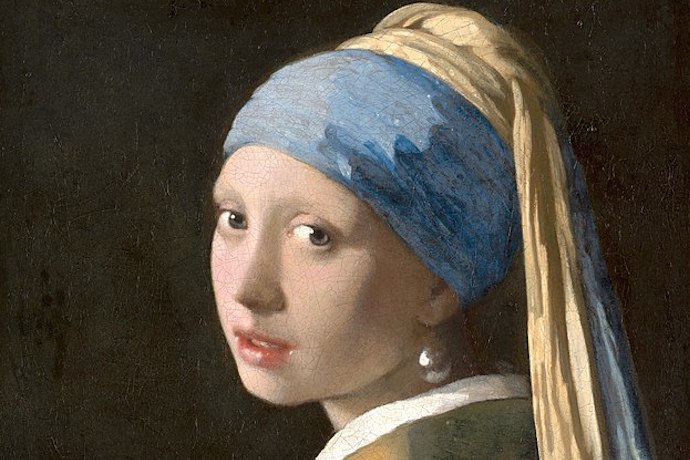
By Hannah Unsworth
A painting, usually a singular image, has far less space than a film to tell a story, yet frequently inspires the newer art form. Classical paintings consistently impact filmmaking, from serving as models for iconic set design to inspiring entire projects. Here are five famous films inspired by paintings.
Girl with a Pearl Earring (2003) by Peter Webber, inspired by Girl with a Pearl Earring (1665) by Johannes Vermeer
Are there any more iconic examples of films inspired by paintings? This one perhaps seems self-explanatory. The title itself should give you a hint – both in its name and use of visual imagery, the film is directly inspired by the iconic 1665 Vermeer painting. A fictionalized retelling of the artwork’s creation and the events surrounding it, Webber’s film attempts to make sense of Vermeer’s famously enigmatic subject. Interestingly, Vermeer’s unnamed woman has inspired a string of adaptations, the most notable being Tracy Chevalier’s 1999 novel which served as the source for Webber’s film. Chevalier, having bought a poster of the famous painting at 19 years old, was enticed by the ‘mass of contradictions’ in the face of the mysterious woman; she was both ‘innocent yet experienced, joyous yet tearful, full of longing and yet full of loss.’
Melancholia (2011) by Lars von Trier, inspired by Ophelia (1851-2) by John Everett Millais
Continuing the theme of films inspired by paintings, Lars Von Trier’s exploration of mental illness makes several references to John Everrett Millais’s ‘Ophelia’ throughout the film’s prologue, with the most notable being a still of Kirsten Dunst, lying in a river, holding a bunch of flowers. Just by observing the images, the allusion is clear: the flowers, the river, Dunst’s haunting beauty, all combine to recreate, through the cinematic medium, the mystique of Millais’s original artwork. The painting itself is even featured in the background of a shot to ensure the viewer does not miss the intended connection. Having previously described Pre – Raphaelite paintings as an inspiration, Von Trier evokes Millais’s famous work to establish the movie’s link between beauty and its capacity for destruction.
The Exorcist (1973) by William Friedkin, inspired by L’Empire des Lumiéres by René Magritte
The inspiration for one of the most iconic building exteriors in cinema history came from an unlikely source. Director William Friedkin, speaking in the 2003 documentary A Decade Under the Influence, named René Magritte’s L’Empire des Lumiéres, as the origin for the famed house: ‘I saw [this painting] in the Museum of Modern Art in New York, it’s called Empire of Light […]. I had that in mind…and I chose the house to match the Magritte painting…the streetlamp…the shaft of light.’ It is Friedkin’s use of light that most emulates the original painting: the strange mix of darkness and light in both jars the senses and contributes to the general sense of eeriness that permeates this essential horror flick.
Psycho (1960) by Alfred Hitchcock, inspired by House by the Railroad (1925) by Edward Hopper
It seems that classic horror has no shortage of exteriors modelled after famous artworks. Continuing our list of films inspired by paintings, Alfred Hitchcock’s Psycho borrows the aesthetic of Edward Hopper’s painting House by the Railroad, to explore concepts of loneliness and urban decay. This marks the second time Hitchcock drew inspiration from a Hopper painting, with the first being for his 1954 classic Rear Window. Unsurprisingly, given his cynical outlook on modern life, Hopper is a popular choice for filmmakers. As Psycho screenwriter Joseph Stefano put it in a 1997 documentary ‘The Making of Psycho’, if Psycho’s Norman Bates was a painting, he ‘would be painted by Hopper.’
Gladiator (2000) by Ridley Scott, inspired by Pollice Verso (1872) by Jean-Léon Gérome
If you’re looking for someone to thank for Ridley Scott’s Gladiator, look no further than French artist Jean-Léon Gérome. His painting, Pollice Verso, meaning ‘with a turned thumb’ in Latin, inspired Scott’s much-loved movie. According to producer Douglas Wick in The Hollywood Reporter, Gérome’s artwork was brought to Scott to encourage him to sign on to the movie: ‘Ridley looked at the painting and said, ‘I’ll do the movie. Wherever the script is, we’ll get it right. I’m doing this movie.’ To Scott, Gérome’s vision of Rome demonstrated all the ‘glory and wickedness’ of the Empire. ‘I knew right then and there I was hooked,’ Scott recalls in the book Gladiator: The Making of the Ridley Scott Epic.